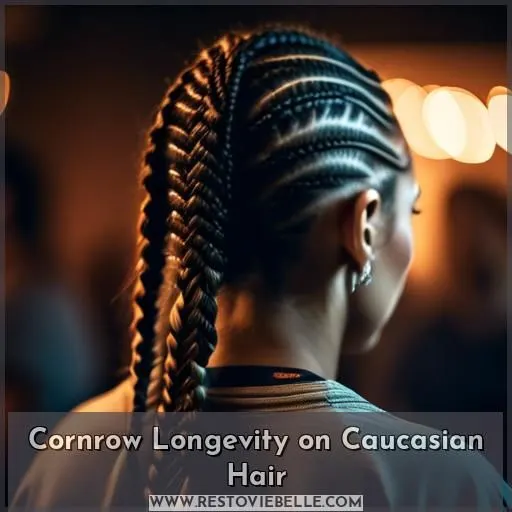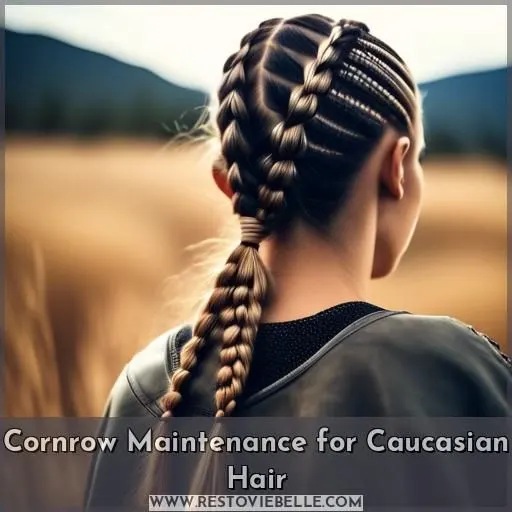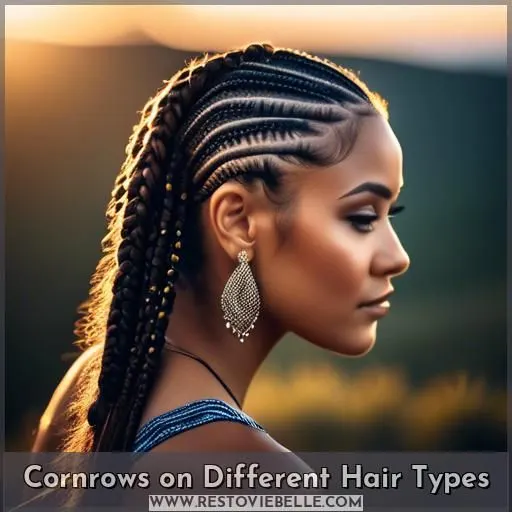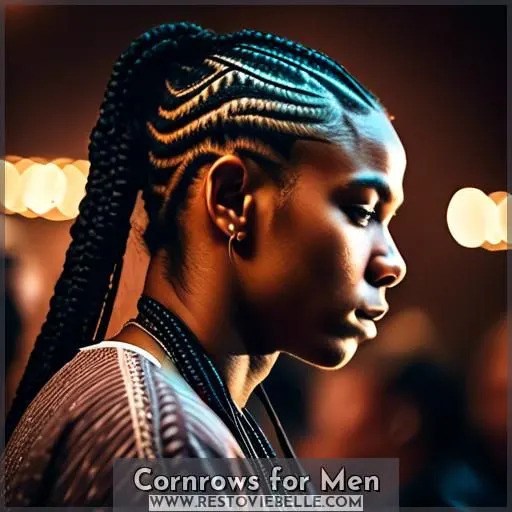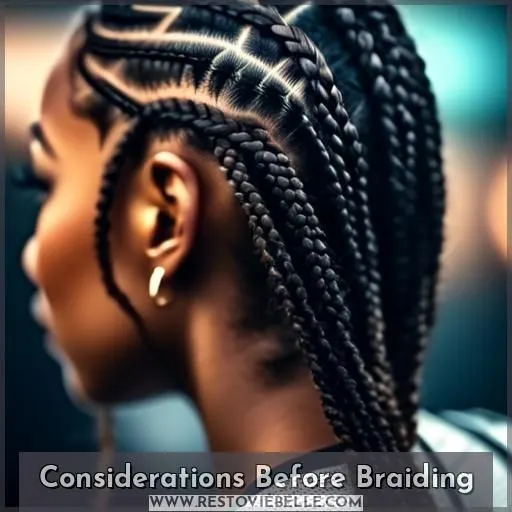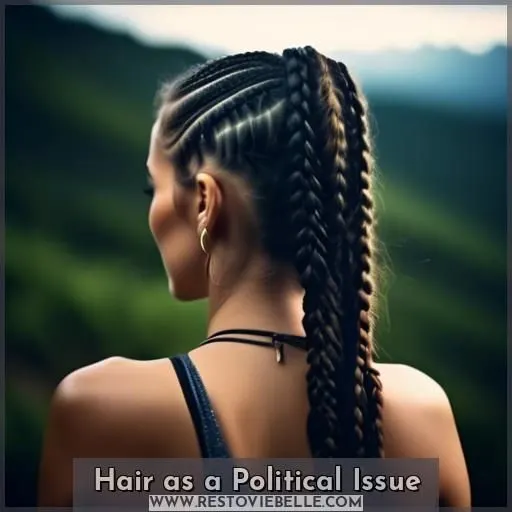This site is supported by our readers. We may earn a commission, at no cost to you, if you purchase through links.
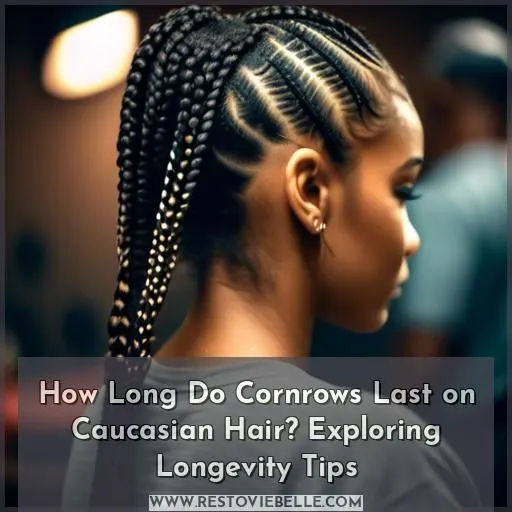
Cornrows can last 2-8 weeks on Caucasian hair, depending on factors like hair type, styling technique, and maintenance routine.
Fine, thin hair tends to loosen quicker, while coarse strands hold cornrows longer.
You’ll maximize longevity by choosing a skilled braider, moisturizing regularly with lightweight products, and protecting your hair at night.
Avoiding harsh practices like over-tightening braids or using heavy products also helps.
With proper care and the right expectations, you can rock fresh cornrows for an extended period.
To truly maximize their lifespan, consider additional tips tailored to your unique hair needs.
Table Of Contents
- Key Takeaways
- How Long Do Cornrows Last on Caucasian Hair?
- Cornrow Longevity on Caucasian Hair
- Cornrow Maintenance for Caucasian Hair
- Cornrows on Different Hair Types
- Cornrows for Men
- Considerations Before Braiding
- Hair as a Political Issue
- Frequently Asked Questions (FAQs)
- How long do cornrows last on caucasian hair?
- What are the recommended aftercare tips for maintaining cornrows on caucasian hair?
- What are the potential risks of wearing cornrows on caucasian hair?
- How can caucasian women ensure they find a reputable braider for their cornrows?
- Are there any specific products recommended for maintaining cornrows on caucasian hair?
- Conclusion
Key Takeaways
- Cornrows can last between 2-8 weeks on Caucasian hair, depending on factors like hair type, styling technique, and maintenance routine.
- Fine, thin hair tends to loosen quicker, while coarse strands hold cornrows longer.
- Proper care and the right expectations can help maximize the lifespan of cornrows on Caucasian hair.
- Tips for maximizing cornrow longevity include choosing a skilled braider, moisturizing regularly with lightweight products, and protecting your hair at night.
How Long Do Cornrows Last on Caucasian Hair?
Cornrows on Caucasian hair can last up to 6 weeks, depending on how the hair is prepared during the cornrow process. Proper aftercare, such as moisturizing the scalp, oiling the hair, and protecting it while sleeping, can help extend the lifespan of cornrows.
Additionally, using a professional hairstylist who specializes in cornrows on straight hair can also contribute to their longevity.
Cornrow Longevity on Caucasian Hair
The longevity of cornrows on Caucasian hair depends on various factors, including hair growth rate, hair type, and maintenance practices. To extend the lifespan of your cornrows, you’ll need to properly moisturize your hair and scalp, protect your tresses during the night, and follow a routine that involves washing with sulfate-free shampoo and regularly conditioning.
Typical Lifespan
Cornrows on Caucasian Hair: Longevity and Maintenance Tips
Cornrows on Caucasian hair can last between 2-8 weeks, depending on factors such as hair type, maintenance, and care. Here are some tips to help you maintain your cornrows and ensure they last as long as possible:
- Choose a professional stylist: Find a hairstylist with experience in working with Caucasian hair to ensure the cornrows are done correctly and not too tight.
- Moisturize with natural oils: Regularly apply natural oils, such as jojoba or coconut oil, to keep your hair and scalp moisturized.
- Protect at night: Wear a satin or silk cap to protect your cornrows from friction and damage while sleeping.
- Wash with sulfate-free shampoo: Use a gentle, sulfate-free shampoo to clean your cornrows without stripping them of their natural oils.
- Condition regularly: Apply a leave-in or diluted conditioner to your cornrows to keep them hydrated and prevent breakage.
- Avoid harsh weather: Protect your cornrows from extreme weather conditions, such as strong winds or heavy rain, which can cause damage.
- Detangle with care: Gently detangle your cornrows to avoid breakage, using a wide-tooth comb or your fingers.
Factors Affecting Longevity
Factors Affecting Cornrow Longevity on Caucasian Hair
The longevity of cornrows on Caucasian hair is influenced by several factors. These factors include hair type, styling options, hair products, personal expression, and maintenance practices.
Hair Type: The texture and strength of Caucasian hair can affect how long the cornrows will keep their desired appearance. Fine hair may appear looser or slip more quickly, while coarse or thick hair can withstand styles like cornrows better due to its robust structure. Curly or kinky hair naturally interlocks better, which can aid in keeping cornrows tight and well-defined. Oily hair may cause braids to slip more efficiently, while dry hair may retain braids better due to reduced slippage.
Styling Options: A skilled braider is crucial for a lasting style. Tight and neat braiding ensures that the cornrows will stay intact for longer, but the braids mustn’t be too tight, which can cause discomfort and even hair loss due to tension. The balance between firm braids and scalp health is essential for longevity.
Hair Products: Using lightweight oils or braid sprays designed to nourish your hair and keep your cornrows looking shiny without producing buildup can help extend the style’s life and preserve scalp and hair health. Regular cleansing to eliminate residue is also necessary for a clean and lively appearance.
Personal Expression: The desire to express oneself through hairstyles is a fundamental human need. Cornrows can be a personal choice for Caucasian individuals, just as they’re for people of other races. The decision to wear cornrows or transition to natural hair is a personal one, and it shouldn’t be dictated by societal expectations or pressure.
Maintenance Practices: Regular care can lengthen the life of your cornrows. Wearing a silk veil or bonnet at night helps avoid frizz and keep braids clean. Keeping your scalp fresh and conditioned will also help minimize peeling and itching, which can contribute to early braid removal. Avoiding heavy treatments that can cause buildup when wearing cornrows is essential to maintain a clean and lively appearance.
Hair Growth Rate
When diving into cornrow styling, understanding your hair’s growth rate is crucial.
Your locks don’t just sprout overnight; they follow a hair growth cycle.
A solid hair care routine can minimize hair damage, ensuring your cornrows look fresh longer.
Whether it’s feed-in braids or traditional cornrows, the longevity on Caucasian or mixed hair hinges on this cycle.
Hair Type Influence
Cornrows can last between 2-8 weeks on Caucasian hair, depending on factors such as hair texture, growth patterns, and cornrow tightness.
- Hair Texture: Caucasian hair is typically finer and less dense than African hair, which can affect the longevity of cornrows. However, with proper care, cornrows can last up to 8 weeks on Caucasian hair.
- Growth Patterns: The growth rate of Caucasian hair is generally slower than that of African hair, which can influence how long cornrows last. Regular trims and maintenance can help maintain the style.
- Cornrow Tightness: Tight cornrows can cause tension headaches and stress on hair follicles, potentially leading to breakage. It’s essential to find a balance between a secure style and one that doesn’t put too much strain on the scalp.
Maintenance Practices
To ensure cornrows on Caucasian hair last, meticulous protective measures are crucial. Scalp health is vital, so regular care is essential. Gentle removal of cornrows is advised, and it’s not merely about appearance; hair growth underpins the longevity of these styles.
Moisturizing
Moisturizing is crucial for maintaining cornrow longevity. Here are four key practices:
- Choose the right moisturizing products: Opt for lightweight, non-greasy options that won’t weigh down your hair.
- Apply moisturizer regularly: Use a spritz bottle or leave-in conditioner to keep your hair hydrated.
- Avoid over-moisturizing: Too much product can lead to build-up and damage.
- Consider the cultural significance: Moisturizing isn’t only about hair health but also personal expression and societal expectations.
Scalp Care
Scalp care is crucial for maintaining the longevity of cornrows on Caucasian hair.
To keep your scalp healthy, avoid harsh chemicals and opt for sulfate-free shampoos.
Regularly moisturize with natural oils, such as coconut or jojoba oil, to prevent scalp dryness and irritation.
Protect your scalp at night with a satin or silk cap to minimize tension and promote scalp health.
Protective Styling
Protective styling is a crucial aspect of maintaining cornrows on Caucasian hair.
- Styling versatility: Experiment with different styles and techniques to find the best fit for your hair type and desired look.
- Cultural expression: Embrace the cultural significance of cornrows and use them as a way to express your heritage or appreciation for diverse styles.
- Artistic expression: Let your cornrows be a canvas for creative expression, incorporating beads, braids, or other embellishments to make them uniquely yours.
- Identity exploration: Use your cornrows as a way to explore and express your personal identity, whether it’s a reflection of your personality or a statement about your beliefs.
Cornrow Maintenance for Caucasian Hair
Proper cornrow maintenance for Caucasian hair is crucial to extend their longevity. Consulting a professional stylist, moisturizing with natural oils, protecting hair at night, washing with sulfate-free shampoo, conditioning regularly, avoiding harsh weather conditions, and detangling carefully are essential steps to keep cornrows neat and prevent breakage.
Professional Stylist Consultation
To ensure the longevity of your cornrows on Caucasian hair, it’s crucial to consult a professional hairstylist who is experienced with cornrow braids.
Their expertise will help you avoid damaging your hair and scalp.
It will also ensure that the braids are done correctly to minimize the risk of breakage and damage.
Additionally, they can provide valuable advice on how to maintain your cornrows and protect your hair from environmental factors.
Moisturizing With Natural Oils
To keep your cornrows looking their best and lasting as long as possible, it’s essential to moisturize your hair with natural oils.
This step is crucial for edge protection, scalp health, and tangle prevention.
By applying light oils like jojoba or almond oil to your scalp and along the length of your cornrows, you can maintain a healthy, moisturized scalp without causing buildup.
Regularly moisturizing your hair with natural oils will also contribute to hair growth and styling versatility.
Nighttime Protection
Nighttime protection is crucial for maintaining the longevity of your cornrows. The right nighttime care routine can help keep your hair looking neat and prevent damage.
- Protective Styling: Cornrows are a protective hairstyle that can last up to 6 weeks if properly maintained. However, it’s essential to protect your hair while you sleep to ensure maximum longevity.
- Satin Bonnets, Silk Scarves, and Hair Caps: These materials are perfect for protecting your cornrows at night. They minimize friction and prevent your hair from rubbing against harsh materials like cotton pillowcases, which can cause frizz and breakage.
- Satin Pillowcases: If you prefer not to use a bonnet or scarf, a satin pillowcase can also help protect your hair. It reduces friction and keeps your hair hydrated.
- Bonnet Over Scarf: For high or mid-height buns, it’s recommended to wear a bonnet over a silk scarf. This combination keeps your bun protected and neat while you sleep.
- Secure Your Accessories: If you have problems with scarf slippage, you can secure your scarf with a few large flat bobby pins around the front perimeter before putting on the bonnet. This helps keep your scarf and bonnet in place during the night.
Washing With Sulfate-Free Shampoo
Washing your cornrows with sulfate-free shampoo is an essential part of maintaining their longevity and health.
Sulfate-free shampoos are gentler on your hair and scalp, preventing irritation and frizziness.
To wash your cornrows, mix your sulfate-free shampoo with warm water and your favorite oil in a spray bottle, then shake well to get a runny consistency.
Before washing, run warm water over your hair to open up your cuticles and rinse out initial dirt.
Spray the shampoo on your roots, scalp, and cornrows, and lightly massage it into your scalp while squeezing the shampoo down your cornrows to prevent frizz.
Rinse the shampoo off thoroughly to avoid any buildup from the chemicals in your shampoo, which could irritate your scalp.
After washing, it’s recommended to condition your cornrows regularly with a moisturizing conditioner and warm water to keep them hydrated and shiny.
Conditioning and Weather Protection
To keep your cornrows looking fresh and healthy, conditioning and weather protection are crucial. Use leave-in or diluted conditioners, and avoid harsh weather conditions. Protect your hair with satin or silk caps at night. Wash with sulfate-free shampoos to maintain your cornrows’ longevity. Regularly condition your hair to keep it moisturized and strong.
Regular Conditioning
Embrace a regular conditioning routine to keep your cornrows looking their best.
Aim for weekly conditioning with a diluted conditioner or leave-in treatment.
Select natural oils to moisturize your scalp and braids.
Massage your scalp to stimulate hair growth.
Protect your hair with a satin or silk cap at night.
Avoiding Harsh Weather
To maintain the longevity of your cornrows, it’s crucial to avoid harsh weather conditions that can damage your hair.
- UV Protection: Protect your cornrows from the sun’s harmful UV rays by wearing a hat or using a hair product with built-in sun protection. This will help prevent damage to your hair and scalp.
- Moisture Retention: Keep your cornrows moisturized by using natural oils or a water spritz. This will help maintain the health of your hair and prevent it from drying out and becoming brittle.
- Product Selection: Choose hair care products that are specifically designed for cornrows. Look for sulfate-free shampoos and conditioners that are gentle on your hair and scalp. Avoid harsh chemicals that can strip your hair of its natural oils and cause damage.
- Avoid Harsh Weather: Try to avoid exposing your cornrows to extreme temperatures, such as hot sun or cold winds. These conditions can cause your hair to become dry and brittle, leading to breakage and damage. Instead, opt for indoor activities or protective styling options when the weather is unfavorable.
Detangling With Care
Detangling your cornrows with care is crucial for maintaining their longevity.
Use a wide-toothed comb or your fingers to gently detangle your hair.
Always start from the ends and work your way up to the roots.
If you’re experiencing tangles, use a detangling spray or apply some oil to your hair before detangling.
Remember to be patient and avoid pulling or tugging at your hair.
Protective hair coverings like satin or silk scarves can help prevent tangles while you sleep.
Regular scalp massages also promote hair growth and can help prevent tangles.
Cornrows on Different Hair Types
For those with different hair types, cornrow longevity can vary significantly. Feed-in braids on tightly coiled hair may last only 2-4 weeks, while mixed textured hair could hold cornrows neatly for 6-8 weeks.
White girl cornrows on straight or wavy hair generally remain presentable for around 5-6 weeks with proper maintenance.
Feed-in Braids
Feed-in braids, also known as cornrows, offer a variety of styling options for Caucasian hair.
These braids can last between 2-4 weeks, depending on factors like hair growth rate and maintenance routine.
To ensure longevity, consider using hair accessories and following a meticulous maintenance routine.
Mixed Hair Cornrows
If you’re considering mixed hair cornrows, the longevity can vary depending on the hair texture and the maintenance practices. Mixed hair, which is a result of a biracial mix of hair genes, can be resilient and can last for about 6-8 weeks with proper maintenance. This is because mixed hair often has a unique texture that can hold styles well.
To make your mixed hair cornrows last longer, consider these tips:
- Professional Stylist Consultation: Find a hairstylist with experience in working with mixed hair to ensure the braids are done correctly and won’t cause damage.
- Moisturizing: Regularly moisturize your hair with natural oils or water spritz to keep it hydrated and prevent breakage.
- Nighttime Protection: Cover your hair with a satin or silk cap at night to protect it from friction and maintain its moisture.
- Washing: Wash your hair with a sulfate-free shampoo and natural oils to keep it clean and conditioned.
- Conditioning: Regularly condition your braids, scalp, and roots with a leave-in or diluted conditioner to keep them healthy.
White Girl Cornrows
When it comes to white girls wearing cornrows, cultural authenticity and racial sensitivity are crucial considerations.
It’s essential to respect the origins of the style and understand its significance in different cultural contexts.
Hair diversity is a vital aspect of personal expression, and style evolution should be embraced with an open mind.
To ensure a positive experience, seek out a professional hairstylist who’s experienced in working with different hair types.
They can provide guidance on maintenance and care.
Cornrows for Men
For men with Caucasian hair, cornrows typically last around 2-4 weeks, though proper maintenance is key to maximizing their longevity. You’ll want to stock up on the right hair products, like moisturizing oils and a satin head cap for nighttime protection, and be prepared to accommodate some styling precautions to prevent excessive hair loss or breakage.
Longevity
Cornrows on Caucasian hair can last between 2-6 weeks, depending on factors such as hair type, maintenance, and styling options. For Caucasian hair, a good hair care routine is essential to maintain the longevity of the cornrows.
- Choose a Professional Stylist: Find a hairstylist with experience in working with Caucasian hair. They can ensure the cornrows aren’t too tight and help prevent damage to your hair.
- Moisturize: Regularly moisturize your cornrows to prevent your scalp from drying up, which can lead to itching and damage.
- Protect Your Hair: Use a silk or satin cap at night to protect your cornrows from friction and breakage.
- Wash Carefully: Wash your cornrows with a sulfate-free shampoo and natural oils to maintain the health of your hair.
- Condition Regularly: Condition your cornrows and scalp to promote hair growth and prevent breakage.
- Avoid Harsh Weather: Protect your cornrows from harsh weather conditions, as extreme temperatures can damage your hair.
- Detangle With Care: When detangling your cornrows, be gentle to avoid damage.
Hair Product Stocking
Stock up on hair products, including a head cap, to maintain your cornrows. Opt for natural oils for moisturizing and protection. Create a hair care routine that includes regular conditioning and weather protection. Keep your braids in for a maximum of six weeks, then cut off the end to remove them. Detangle with care to avoid damage.
Precautions and Considerations
When it comes to cornrows on Caucasian hair, there are several precautions and considerations to keep in mind. Firstly, ensure proper braid tension to prevent damage and maintain scalp sensitivity. Secondly, consider your hair texture and growth pattern to determine the most suitable style. Lastly, respect cultural norms and avoid appropriation, as cornrows hold significant cultural significance for many communities.
Styling Tips
To ensure your cornrows last, consider these styling tips:
- Choose the right pattern: Opt for simple, straight cornrows for a classic look or try more intricate patterns for a unique style.
- Accessorize: Add beads or other hair accessories to enhance your braids and add a personal touch.
- Protective styles: Cornrows can be a protective style, so consider wearing them for a week or two at a time.
- Maintenance tips: Keep your hair moisturized and avoid harsh chemicals. Use a wide-tooth comb to detangle and avoid breakage.
- Embrace your style: Don’t be afraid to experiment with different lengths and textures. Your cornrows are a reflection of your personal style and creativity.
Hair Loss and Breakage
Cornrows, a popular protective hairstyle, can be beneficial for hair growth and retention if executed correctly.
- Avoid Overly Tight Cornrows: Tight cornrows can cause traction alopecia, a form of hair loss due to the pulling of hair follicles. Make sure your cornrows aren’t too tight and avoid pulling on your hair.
- Moisturize Your Hair: Keep your hair moisturized to prevent breakage. Use natural oils like olive or coconut oil to nourish your hair and scalp.
- Protect Your Scalp: Protect your scalp from tension by loosening your cornrows around your hairline. This will help reduce the risk of hair loss.
- Change Your Hairstyle: Don’t wear cornrows for too long without a break. Give your hair a rest and switch to a different hairstyle every few weeks.
- Consult a Professional Stylist: If you’re unsure about the tightness of your cornrows, consult a professional hairstylist who can ensure they’re done correctly.
Considerations Before Braiding
Before braiding your hair into cornrows, you should be prepared for some potential discomforts and make educated decisions.
Getting cornrows installed can lead to migraines and sleep disturbances for the first few days.
Washing too infrequently may result in an unpleasant odor known as braid stank.
However, finding an experienced braider and following proper maintenance techniques like moisturizing, protecting your hairline, and gently cleansing can help mitigate these issues and ensure your cornrows last as long as possible.
Migraines and Sleep Loss
As you navigate the complexities of braiding, it’s crucial to consider the impact on your health. Cornrows may lead to headaches and sleep loss due to migraine triggers. Prioritize good sleep hygiene and circadian rhythm to mitigate these issues. Remember, your well-being isn’t just about your hair; it’s about your overall health.
Washing Frequency
Washing frequency is a crucial factor when it comes to caring for your cornrows. Cornrows are a protective hairstyle that can last 2-8 weeks, depending on the hair type and maintenance practices. For Caucasian hair, washing every 7 to 10 days is recommended to keep the scalp healthy without damaging the braids. It’s essential to use a shampoo foaming cleanse, as regular shampoo can cause frizzing due to friction. After washing, apply a foam or mousse to keep the braids looking neat and polished.
Proper cleansing is essential for scalp health, which is the root of healthy, happy hair. Skipping washdays can reverse the benefits of protective styles like cornrows, leading to stress on the scalp, buildup of products, sweat, dirt, dandruff, dead skin cells, and bacteria that clog pores, causing pimples on the scalp. Washing your hair in a protective style shouldn’t be a chore but a cherished moment.
Dealing With Braid Stank
Dealing with braid stank can be a common concern when wearing cornrows, especially for those with naturally oily hair.
To combat this issue, you can use natural oils to moisturize your scalp and hair. For instance, almond oil or coconut oil can be used to seal in moisture and prevent odor build-up.
Additionally, wet cloth washing techniques can be employed to clean between braids, ensuring that your hair remains fresh and clean.
Scalp hygiene plays a crucial role in maintaining the longevity of your cornrows, so it’s essential to maintain a regular cleansing and conditioning regimen.
Comfort With Washing With a Wet Cloth
Washing your cornrows with a wet cloth is a matter of personal comfort and preference. Some people might find it uncomfortable or difficult to wash their cornrows with a wet cloth, while others mightn’t have any issues with it.
- Wet Cloth Concerns: Washing your cornrows with a wet cloth might cause the braids to loosen or frizz, especially if the cloth is too rough or abrasive. It’s essential to use a soft, gentle cloth that won’t damage the braids.
- Cloth Cleaning Alternatives: If you’re not comfortable washing your cornrows with a wet cloth, you can try other methods, such as using a spray bottle to apply shampoo directly to the scalp and braids, or using a shower cap or plastic bag to protect the braids while washing the rest of your hair.
- Cloth Hygiene Practices: Make sure to wash your cloth regularly to avoid bacteria buildup and maintain cleanliness. You can wash it with your regular laundry or by hand, depending on the fabric.
- Cloth Material Considerations: Choose a cloth made from a soft, breathable material like silk or satin to minimize friction and protect the braids.
Ultimately, the choice of washing method depends on your personal comfort level and the condition of your cornrows. Experiment with different methods to find what works best for you and your hair.
Finding a Braider
Finding the right braider is crucial for a successful cornrow experience. Consider factors like location, cost, and the braider’s experience and reputation. Ask about their professional work and maintenance instructions to ensure a long-lasting and healthy style.
Maintaining Braids
Maintaining braids is crucial for their longevity.
Wash your hair once a week or every two weeks with a sulfate-free shampoo and natural oils.
Use a wet cloth to clean between braids and massage your scalp to encourage hair growth.
Style your hair down to minimize hair loss and protect it with a silk scarf at night.
When removing braids, be gentle to avoid damaging your hair.
Detangle your braids with care to prevent breakage.
The size of your braids can also affect their lifespan, so consider this when maintaining them.
Protecting Natural Hair
Protecting natural hair is crucial when it comes to wearing cornrows.
Start by moisturizing your roots with a spritz bottle. Condition your braids, scalp, and roots frequently.
Keep your braids in for a maximum of six weeks. Cut off the end of braids to remove them.
Detangle your braids with help to avoid damage.
Braiding Techniques
Before embarking on your braiding journey, consider these essential tips:
- Hair loss and breakage: Be aware that heavy braids can cause hair loss and breakage.
- Washing frequency: Plan to wash your hair once a week or every two weeks to maintain sleekness.
- Finding a braider: Look for a reputable braider with experience to avoid damage and ensure professional work.
Personal Choice and Beauty
As you navigate the complexities of personal expression and beauty, remember that inclusivity is key.
Cultural exchange isn’t only about understanding different hairstyles but also respecting their origins.
Self-acceptance is a powerful tool in breaking free from the constraints of beauty standards.
Whether you choose cornrows or another style, it’s not merely about the hairstyle itself but the message it sends about who you are and what you value.
It’s advisable to embrace your unique style, even if it’s ever-evolving, as it underpins your identity in the ever-changing world of beauty.
Hair as a Political Issue
You’re likely aware that hairstyles, especially those linked to certain cultures or ethnicities, have become politicized and racialized. There’s an ongoing debate around whether white individuals wearing traditionally Black hairstyles like cornrows constitutes cultural appropriation, with some arguing it disrespects the cultural significance of those styles for the Black community.
Hairstyles and Racialization
Hairstyles have become a political issue, with African hairstyles being racialized and appropriated by those outside the culture. The use of cornrows by white women is often seen as cultural appropriation, while black women are pressured to keep their hair natural to show race allegiance. This politicization of hair has led to debates on the symbolism and meaning behind different hairstyles, as well as the pressure to conform to certain beauty standards.
The BBC is running a debate series on African women’s hairstyles, highlighting the importance of understanding the cultural significance of these styles. Amandla Stenberg, an American actress, has spoken out about the issue, accusing white celebrities of cultural appropriation. The symbolism of hair is deeply rooted in African culture, with cornrows serving as a form of self-expression, social identification, and storytelling.
Black women have faced insults about their natural hair, with India.Arie famously stating, I’m not my hair. No woman should feel pressured to defend her hairstyle choice, and black women should be proud of their natural hair. The politics of hair exacerbates the racial divide, with some women dictating how others should wear their hair and accusing those who don’t comply of trying to be white or cultural appropriation.
Mixing and borrowing are fundamental elements of fashion, and hairstyles shouldn’t be exclusive to a certain race. The world of fashion is ever-evolving, and it’s advisable to navigate the complexities of cultural appropriation with care. It’s essential to respect the history and significance of different hairstyles while embracing the creativity and expression that fashion can provide.
Cultural Appropriation
Cultural appropriation is a complex issue that intertwines hair and politics, often blurring the lines between appreciation and exploitation.
As a Caucasian individual, it’s essential to respect the origins and cultural significance of hairstyles like cornrows.
Embrace your personal autonomy in choosing your hairstyle, but be mindful of the impact your choices may have on others.
Pressure to Keep Hair Natural
As a Caucasian woman, you may feel pressured to keep your hair natural to show race allegiance, a political issue that exacerbates the racial divide in society.
This pressure can be daunting, especially when navigating the complexities of societal beauty standards. It’s not merely about your hair; it’s about embracing your identity and personal choice.
Amandla Stenberg’s Perspective
Amandla Stenberg, a young and outspoken actor and activist, has shared her perspective on the politics of hair, cultural appropriation, and personal choice in various interviews and social media posts.
She’s openly discussed her experiences with hair, including her decision to embrace her natural curls and experiment with different styles, such as box braids.
Stenberg has also spoken out against cultural appropriation, advocating for understanding and respect for the history and significance of different hairstyles within various cultural contexts.
She’s encouraged people to appreciate the symbolism of hair and to celebrate the freedom of wearing different hairstyles without being judged or accused of appropriation based on their race.
Stenberg’s views reflect a desire for unity and a rejection of the divisive nature of hair politics, emphasizing the importance of individual choice and expression in personal appearance.
BBC Debate Series
Hair is a deeply personal and political issue, especially for Black women. The way we wear our hair can be a statement about our cultural identity, our political beliefs, and even our economic status. In recent years, the debate surrounding hair discrimination has gained significant attention, with the CROWN Act being passed in California and Illinois to prohibit discrimination based on hairstyle and texture.
The politics of hair is complex and ever-evolving. It’s not merely about personal choice but also about the societal pressures and expectations that come with different hairstyles. For example, Black women have faced discrimination for their natural hair textures, which are often seen as unprofessional or unkempt in certain workplaces. Conversely, some Black women have chosen to embrace their natural hair as a symbol of pride and resistance against Eurocentric beauty standards.
The debate around hair also intersects with race and culture. In some cases, white women wearing cornrows or other Black hairstyles is seen as cultural appropriation, while Black women are pressured to keep their hair natural to show race allegiance. This dynamic highlights the complexities of identity politics and the role that hair plays in shaping our perceptions of race and culture.
In the realm of fashion, hair is a fundamental element of personal expression and creativity. Mixing and borrowing styles from different cultures is a natural part of the fashion industry, but it’s essential to do so in a respectful and sensitive manner. As we navigate these complexities, it’s crucial to remember that hair is more than just a physical attribute; it’s a deeply personal and political statement about who we’re and how we choose to present ourselves to the world.
Symbolism of Hair
In the tapestry of hair politics, each strand weaves a story of cultural identity, challenging social norms and racial stereotypes. Your hair, a canvas of personal expression, speaks volumes without uttering a word. It’s a silent rebellion against the cookie-cutter expectations of society, a nod to where you’ve been, and a bold declaration of where you’re headed.
No Pressure to Defend Hairstyle Choice
You shouldn’t feel pressured to defend your hairstyle choice, as it’s a reflection of your individuality and self-expression.
Embrace your hair, whether braided or natural, as a symbol of empowerment and acceptance.
It’s about embracing the complexities of the world and navigating them with confidence.
It’s all about finding a hairstyle that makes you feel good and expresses your unique identity.
Pride in Natural Hair
Embrace your natural hair with pride, as it’s a powerful symbol of your cultural identity and self-expression. Society’s norms shouldn’t dictate how you wear your hair. Your personal style is a reflection of your unique journey, so wear your cornrows with confidence, knowing they can last up to 6 weeks with proper care.
Politics of Hair
In the tangled web of hair politics, your locks are more than just strands; they’re a statement of Black power, a nod to cultural identity, and a battleground against racial discrimination.
Choosing cornrows isn’t just about self-expression; it’s a stand against hair discrimination.
Mixing and Borrowing in Fashion
In the realm of fashion, cultural borrowing is a common practice that has been shaping style trends for centuries.
It’s not merely about wearing an item of clothing or a hairstyle from another culture; it’s about personal expression and embracing diversity.
As we navigate the complexities of fashion choices, it’s essential to remember that societal norms can be ever-evolving.
In the heart of the ever-changing world of fashion, it’s crucial to be meticulous in our suite of choices, ensuring they are designed to enhance our personal style, not merely follow the latest trend.
Frequently Asked Questions (FAQs)
How long do cornrows last on caucasian hair?
You’ll usually get 5-6 weeks with cornrows in Caucasian hair. It holds the style pretty well, but proper maintenance — keeping them moisturized and limiting friction — is key to making them last.
What are the recommended aftercare tips for maintaining cornrows on caucasian hair?
You’ll need to moisturize daily with leave-in conditioners and oil your scalp. Sleep in a satin bonnet, and hit those roots with dry shampoo when needed. With proper care, caucasian cornrows can last 4-6 weeks.
What are the potential risks of wearing cornrows on caucasian hair?
Oh, you daring soul! Caucasian cornrows risk severe breakage, thinning, even baldness if worn too long. Those delicate strands can’t withstand the tension. Protect your crowning glory – take preemptive action!
How can caucasian women ensure they find a reputable braider for their cornrows?
To find a skilled braider, ask around for recommendations from friends with cornrows. Check reviews online and look at their portfolio. A consultation can help gauge their expertise before committing.
Are there any specific products recommended for maintaining cornrows on caucasian hair?
You’ll want to stock up on moisturizing products like leave-in conditioners and oils to keep those strands hydrated and sleek. A satin or silk scarf also helps preserve the style overnight – no frizz, no stress!
Conclusion
Navigating the longevity of cornrows on Caucasian hair is a unique journey.
With the proper techniques and care routine, you can maximize their lifespan, rocking fresh cornrows for weeks.
Consult a skilled braider.
Moisturize regularly.
Protect your strands at night.
Embrace your hair’s individuality.
Ultimately, how long cornrows last on Caucasian hair depends on your commitment to nurturing your tresses.
